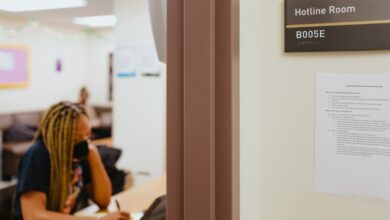How Purdue U.’s Income-Share Agreement Confused Students

[ad_1]
A Purdue University financial-aid program that promised to reshape the way students paid for college has come under national scrutiny from some consumer advocates and disgruntled borrowers.
The program, originally dubbed “Bet on a Boiler” in 2015, was the first of its kind at a major university: An “income share agreement” that provided tuition aid to students in exchange for a small percentage of the student’s future earnings.
Seven years later, the program, now called “Back a Boiler,” is managed by the university’s nonprofit foundation and has provided some $21 million to about a thousand students, a fraction of the university’s undergraduate enrollment of more than 35,000.
But in recent months, the plan has attracted a wide range of critics, including some students who received aid and their parents. The Student Borrower Protection Center, a left-leaning watchdog group, has asked the U.S. Department of Education to investigate whether the university is violating federal lawby promoting a loan program that it helps run. The department has also issued a reminder to colleges of their legal obligations when offering income-share agreements.
A written statement from Tim Doty, a Purdue spokesman,denies that the university is breaking any laws and says that the university seeks to provide clear information to students about how the plan works and what amount they would be obligated to pay.
Despite those disclosures detailing possible outcomes, some students who signed a contract for the program feel they were duped.
Florin Handelman, who graduated from Purdue a year ago with a bachelor’s degree in industrial product design, said the program feels like a form of “predatory lending,” because it preys on student fears of being deep in debt.
Handelman said he remembers getting a lot of fliers from the university that promoted the income share as a way to avoid more student debt.
“This is great,” Handelman recalls thinking at the time. “I should definitely look into this.”
‘Creative Alternative’
“Back a Boiler” is exactly the kind of program one might expect from the university’s president, Mitchell E. Daniels Jr., the former Republican governor of Indiana who has sought to transform Purdue by making it more efficient and less expensive for students. Daniels, for example, has frozen tuition for a decade and even lowered the cost of room and board.
In addition to raising more money for financial aid through institutional grants, Daniels sought to harness the power of the free markets. To pay for the program, the foundation created two private companies to attract investors to provide the student aid.
The investors who are backing the program will want a return on their money, said Carlo Salerno, vice president for research at CampusLogic, a tech company that focuses on enrollment and financial-aid programs. But they can’t just pressure every student to participate, he said, because in order to get that return, the students have to be successful.
The university explains that the income-share agreement — or ISA — is just one of several options offered to students.
It is, however, touted as a way to escape more student loans — an enticing possibility in an environment where stories of students buried by six-figure student debt are commonplace. (Students with more than $100,000 in debt actually make up just 5 percent of borrowers.)
“You don’t have to be saddled with debt. There’s a creative alternative,” the Back a Boiler website proclaims.
The marketing may appeal to parents as much as students, said Justin Draeger, president and chief executive of the National Association of Student Financial Aid Administrators. Parents don’t have to co-sign for ISAs the way they do for student loans.
But initial excitement over the ISA has, in some cases, turned to disappointment and anger, particularly for some who landed a well-paying job after graduating from Purdue.
“It’s clear that in some students’ case, what they were expecting versus what they were getting didn’t align,” Draeger said.
‘Young and Dumb’
Nationally, income-share agreements remain a niche financial-aid option. Various news accounts put the number of programs at a few dozen. The University of Utah’s income-share agreement failed to get enough traction to make it worthwhile. It was paused last year with just 121 students signed up. “It’s highly unlikely the University of Utah will continue with its Income Share Agreement program,” a university spokesperson wrote in an email. “In the three years the ISA has been offered on our campus, it hasn’t been a popular option for us.”
Unlike Purdue, Utah didn’t explicitly promote its program as an alternative to loans. Instead, the university promoted it as a flexible way to “fill funding gaps” so that students could complete their degrees, start a job, and begin earning a salary.
It’s not entirely surprising that students are confused about how income-share agreements really work compared with student loans. What sounds like a small percentage of income can add up to a very high interest rate, especially if you earn more than expected after graduation.
Depending on the major and earnings after graduation, a Purdue student pays between 1.73 percent and 4.97 percent of income for terms of 80 to 116 monthly payments (or roughly seven to 10 years).
For graduates who earn below-average salaries, an income-share agreement can work in their favor. Graduates who earn less than $20,000 annually pay nothing.
But if, for example, they receive $10,000 in aid from the program, and go on to earn $60,000 or more on a 5 percent income-share agreement, the payments could add up to $25,000; Back a Boiler participants could be responsible for paying a maximum of 250 percent of the original amount of aid. That’s far more than would be owed for even a private loan of $10,000 at 9.5 percent interest, which would total a little more than $17,000, according to Purdue.
There are no national data on how Purdue’s maximum repayment compares with other plans. The Utah ISA had a 200 percent maximum. A news article from NerdWallet says payment caps vary from 100 percent to 300 percent of the initial aid, but recommends that students avoid anything over 200 percent.
Purdue said in its written statement that most students will complete the seven-to-10 year payment term without reaching the maximum: “Although we hope all Boilermakers are hugely successful, we anticipate that most ISA terms will expire well before the holder has come close to hitting the payment cap.“
Some students, like Handelman, have offered to pay off their ISA early, but that can only be accomplished by paying off the 250 percent maximum.
“No one is forcing any ISA holder to pay that full amount up front, and there’s no assurance that the total payments would ever reach that cap anyway,” the university said in its statement.
Purdue goes to some lengths now to make sure students understand how the program works. The website provides examples of earnings in different fields and even shows calculations for how much students will pay back depending on those earnings. Students must also pass a quiz showing they understand how the plan works.
Over all, the income-share industry would benefit from more regulation and a commitment to using the same kind of terms and language that is used to offer student loans, said Peter Terebesi, president of Higher Ed Executives, a consulting firm that advises colleges on accreditation and financial compliance.
“A good start would be for schools to ensure students understand that the ISA is a loan that has to be repaid and that students will incur some debt as a result of borrowing,” Terebesi said in an email.
Handelman said he was “young and dumb” when he signed up for the program and doesn’t recall the quiz. But he also thinks the university used calculations that seemed to deflate the amount he might earn in his career in order to make the program seem more appealing. In this case, making more money than he expected also means Handelman will pay more for his income-share agreement.
Now, along with $14,000 in student loans, Handelman said he would probably be stuck paying the maximum $25,000 for his $10,000 income-share agreement. Given his current job, it’s not a devastating problem, but it’s frustrating that he didn’t understand what he was signing up for.
“I don’t have much to complain about,” he said, “but it sucks how it was set up.”
[ad_2]
Source link






